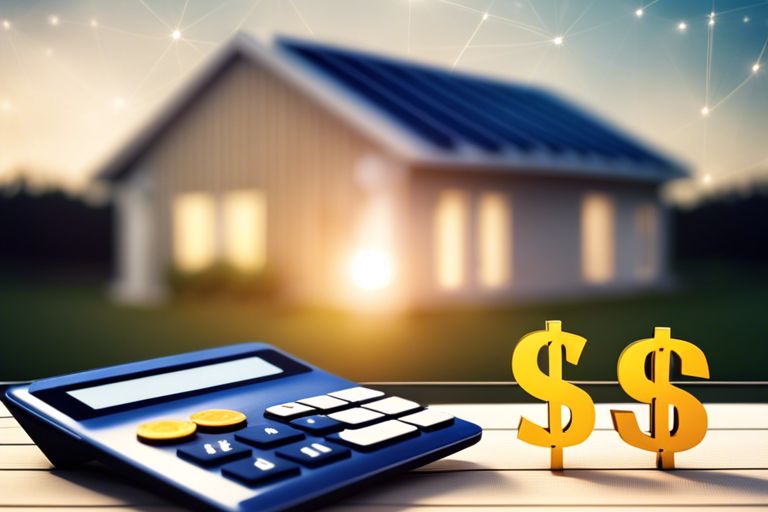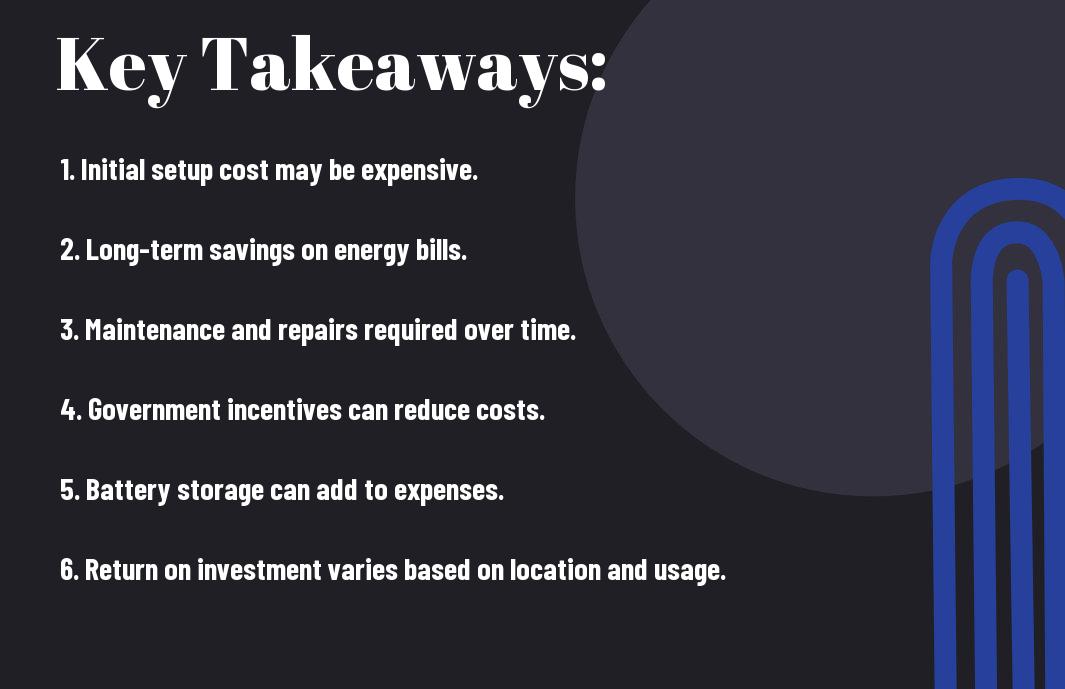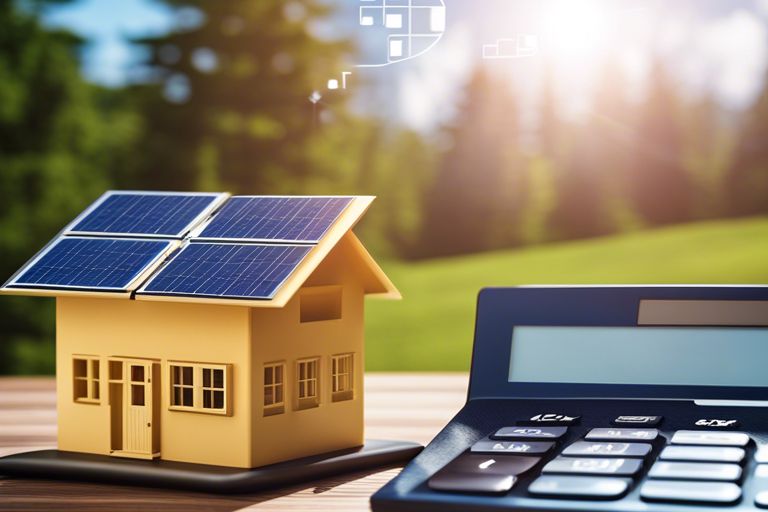It’s time to shed light on the real cost of utilizing solar power in your daily life. When you consider investing in solar panels for your home, it’s necessary to understand the financial implications. From the initial installation expenses to long-term savings on your electricity bills, uncover the true expenditure involved in harnessing the power of the sun. Let’s break down the numbers and explore whether solar energy is a viable and cost-effective option for you.
Key Takeaways:
- Initial Investment: The cost of using solar power includes an initial investment in solar panels, inverters, and installation.
- Long-term Savings: While there is an upfront cost, using solar power can lead to significant long-term savings on utility bills.
- Maintenance Costs: There are minimal maintenance costs associated with solar power, typically limited to occasional cleaning and inspections.
- Government Incentives: Many governments offer incentives such as tax credits or rebates to offset the cost of installing solar panels.
- Environmental Benefits: Choosing solar power can have a positive impact on the environment by reducing carbon emissions and reliance on non-renewable energy sources.

Benefits of Solar Power
Environmental Advantages
For those concerned about the environment, solar power offers significant advantages. By harnessing the power of the sun to generate electricity, you can reduce your carbon footprint and decrease your reliance on fossil fuels. Solar power systems produce clean, renewable energy that doesn’t release harmful greenhouse gases into the atmosphere, helping to combat climate change and protect the planet for future generations.
Energy Independence
The adoption of solar power also provides you with a sense of energy independence. By generating your electricity from the sun, you are less reliant on traditional electricity grids and utilities. This can offer you greater control over your energy consumption and costs, as well as increased resilience in the face of power outages or fluctuations in energy prices. With solar power, you have the ability to produce your electricity right on your property, giving you more autonomy and flexibility in managing your energy needs.
With solar panels installed on your roof, you can not only reduce your electricity bills but also potentially earn money by selling excess energy back to the grid. This means that your solar power system could pay for itself over time, providing you with long-term savings and a valuable investment in your property.
Initial Investment Costs
Any investment in solar power requires an initial upfront cost for equipment and installation. This includes purchasing solar panels, inverters, batteries (if required), mounting hardware, and the cost of labor for installation. The total expense can vary depending on the size of the system you need and the complexity of the installation.
Equipment and Installation Expenses
One factor that influences the cost of solar power is the quality of the equipment you choose. Higher quality solar panels and inverters are more efficient and durable but come at a higher price. Additionally, the size of your solar system will impact the overall cost, with larger systems costing more than smaller ones. Installation costs also vary depending on your location, roof type, and any additional electrical work that may be required.
Government Incentives and Rebates
To help offset the initial investment costs of installing solar power, there are various government incentives and rebates available. These can include federal tax credits, state rebates, and local incentives that can significantly reduce the overall cost of going solar. It’s important to research and take advantage of these incentives to make the switch to solar power more affordable.
Expenses for solar power go beyond just the initial investment. You should also consider ongoing maintenance costs, insurance, and any financing expenses if you choose to finance your solar system. While the upfront costs may seem significant, in the long run, solar power can help you save money on your electricity bills and increase the value of your property.
Ongoing Expenses
Maintenance and Repair Costs
Once again, you may be wondering about the maintenance and repair costs associated with using solar power. To put your mind at ease, solar panels are incredibly durable and require minimal maintenance. Typically, you will only need to clean them a few times a year to ensure optimal performance. However, in the rare event that a panel malfunctions, repairs are usually covered under warranty for the first 20 to 25 years.
Energy Storage Solutions
Energy storage solutions, such as batteries, are becoming increasingly popular for solar-powered homes. By storing excess energy generated during the day, you can use it during peak evening hours or on cloudy days when solar energy production is limited. While these systems come with an initial cost, they can ultimately reduce your reliance on the grid and save you money in the long run.
Energy storage solutions not only provide backup power during outages but also allow you to maximize your energy independence. By investing in a quality battery system, you can store surplus energy and use it when needed, further optimizing your solar power setup.
Cost Comparison
Your energy choices have a direct impact on your wallet. Let’s break down the cost of using solar power compared to traditional fossil fuels and other renewable energy sources.
Solar Power vs. Traditional Fossil Fuels
| Solar Power | Traditional Fossil Fuels |
| The initial investment in solar power can be high, but over time, you can save significantly on your electricity bills as sunlight is free. | Traditional fossil fuels like coal and natural gas come with volatile prices that can fluctuate and increase your energy costs unpredictably. |
Solar Power vs. Other Renewable Energy Sources
| Solar Power | Other Renewable Energy Sources |
| With advancements in technology, the cost of solar panels has been decreasing, making solar power more affordable and accessible. | Energy sources like wind and hydroelectric power may have lower maintenance costs but can be location-dependent and not as universally applicable as solar power. |
Energy sources like wind, hydroelectric, and geothermal power are important alternatives to traditional fossil fuels, but solar power stands out for its versatility and potential for widespread adoption.
Factors Affecting Cost
Many factors can influence the cost of using solar power for your home. Here are some key factors to consider:
- Location and Climate: Any geographical location and climate conditions can impact the cost of installing a solar power system. Regions with abundant sunlight will generally have lower installation costs compared to areas with frequent cloud cover. Additionally, extreme weather conditions like heavy snow or strong winds can affect the maintenance costs of your solar panels.
- System Size and Efficiency: Climate also plays a crucial role in determining the size and efficiency of the solar power system you need. In sunny regions, smaller and less efficient systems may still generate a significant amount of electricity. However, in areas with less sunlight, you may need a larger and more efficient system to meet your energy needs.
Location and Climate
Any geographical location and climate conditions can impact the cost of installing a solar power system. Regions with abundant sunlight will generally have lower installation costs compared to areas with frequent cloud cover. Additionally, extreme weather conditions like heavy snow or strong winds can affect the maintenance costs of your solar panels. This is why it is vital to consider these factors when calculating the overall cost of using solar power.
System Size and Efficiency
Climate also plays a crucial role in determining the size and efficiency of the solar power system you need. In sunny regions, smaller and less efficient systems may still generate a significant amount of electricity. However, in areas with less sunlight, you may need a larger and more efficient system to meet your energy needs.
Factors like the size of your property, your average energy consumption, and the orientation of your roof towards the sun will all influence the size and efficiency of the solar power system you install. It’s vital to assess these factors carefully to ensure that you invest in a system that meets your energy needs efficiently.

Emerging Trends and Innovations
Advancements in Solar Panel Technology
Unlike traditional solar panels, which were bulky and less efficient, advancements in solar panel technology have led to the development of sleeker, more efficient panels. These new panels are not only more aesthetically pleasing but also more powerful, allowing you to generate more electricity from the same amount of sunlight.
Smart Grids and Energy Storage Systems
Advancements in smart grids and energy storage systems have revolutionized the way we use solar power. Smart grids enable you to efficiently manage your energy usage by allowing you to store excess electricity generated by your solar panels for later use. This means that even when the sun isn’t shining, you can still power your home with clean, renewable energy.
Technology has made it possible to integrate energy storage systems with your solar panels, providing you with a reliable source of electricity day and night. By harnessing the power of smart grids and energy storage, you can maximize your solar energy usage and minimize your reliance on the grid, ultimately saving you more money in the long run.

Final Words
The decision to invest in solar power comes with both financial benefits and initial costs. As you’ve learned throughout this article, the cost of using solar power has decreased significantly over the years, making it a more viable option for many homeowners. However, factors such as installation costs, system size, and location can affect the overall price. If you’re considering installing solar panels, be sure to do your research, get multiple quotes, and explore available incentives to help make the investment more affordable. For more information on the cost of solar panels in 2024, you can check out this resource.
The benefits of harnessing solar power extend beyond cost savings, with positive impacts on the environment and energy independence. By carefully weighing the costs and benefits, you can make an informed decision that aligns with your goals and values. Note, the initial investment in solar panels can lead to long-term savings and a more sustainable lifestyle. So, as you continue your journey towards renewable energy, keep in mind the potential long-term gains of embracing solar power for your home.
FAQ
Q: What factors determine the cost of using solar power?
A: The cost of using solar power is influenced by factors such as the size of the system, the quality of the solar panels, installation costs, geographical location, available incentives, and the amount of sunlight the location receives.
Q: How does the size of the solar power system affect the cost?
A: Generally, the larger the solar power system, the higher the initial cost. However, a larger system can also generate more electricity, potentially leading to greater savings on energy bills in the long run.
Q: Are there any incentives or rebates available to help offset the cost of using solar power?
A: Yes, many governments, utility companies, and organizations offer various incentives, rebates, and tax credits to encourage the use of solar power. These incentives can significantly reduce the upfront cost of installing a solar power system.
